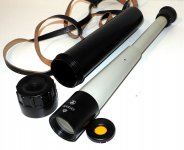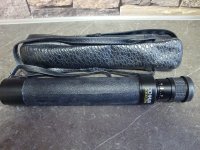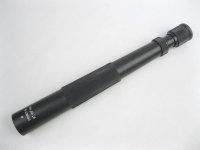Yes, that is the small scope I tested above.
I probably got the 32mm and 40mm zoom scopes twenty or thirty years ago and haven't found the 40mm yet.
I presume that you want to buy one of the USSR scopes because of cost.
The 20x50 Kowa straight scope is much brighter than the 8x-20x32 on a dull day and considerably brighter in full sunshine. In fact the Kowa needs a neutral density filter in bright sunshine.
The Kowa has false colour, the 8x-20x32 less so. The Kowa weighs about the same as the 8x-20x32. The Kowa is shorter anf for me steadier hand held.
I also use an Opticron MM2 13x-39x52 angled eyepiece hand held or braced. This cost about £70.
For 20x and above one needs a tripod, which is additional cost.
Scopes cost up to £4,000, so one has to mention cost before asking which is best.
There is actually no best, only preferences.
Many scopes have interchangeable eyepieces.
Zoom eyepieces usually have smaller fields of view at any particular magnification compared to a fixed magnification eyepiece.
So firstly, how much does one want to pay?
What does one want to look at?
Near or far?
Does one wear glasses etc.?
Where is one observing, over water, fields, houses etc?
The exit pupil, the small circle behind the eyepiece determines how bright the image is.
It depends on the size of the eyes pupil, which typically varies from 2mm to 7mm or 8mm at night in young people.
For far viewing, of the two USSR mentioned I would go with the 20x50 as it is brighter at 20x.
Besides spotting scopes and monoculars there are astro scopes that are usually better than the others for long distances, but not waterproof and not rugged.







